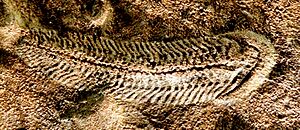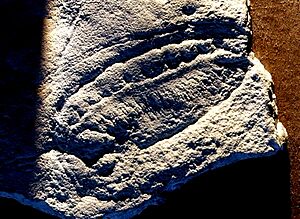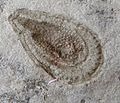Ediacaran biota facts for kids

The Ediacaran biota are very old living things, mostly animals, from the Ediacaran period. This time in Earth's history was from about 635 to 542 million years ago. However, the actual fossils of these creatures are found from 575 to 542 million years ago. This was after a time of many ice ages and just before the Cambrian period began.
These ancient creatures were soft-bodied, meaning they didn't have hard shells or bones. They were also multicellular, made of many cells, like us! They left behind fossils, which are like imprints in rocks from the Ediacaran age.
The Ediacaran biota are quite special and different from other life forms. They appeared after a period called the Marinoan glaciation, where much of Earth was covered in ice. Most of these creatures seemed to disappear in a big extinction event right when the Cambrian period started. Some might have survived into the early Cambrian.
Contents
Groups of Ediacaran Fossils
Scientists have found Ediacaran-type fossils all over the world in about 25 different places. They were found in various environments where sediments settled. These fossils are usually put into three main groups, named after the places where they were first found or are very common. Each group lived in its own type of habitat. Once they appeared, they didn't change much for a long time.
- The Avalon-type group is named after Mistaken Point Ecological Reserve in Newfoundland, Canada. This is the oldest place where many Ediacaran fossils have been found.
- The Ediacara-type group includes fossils found near the mouths of rivers (river deltas). They are preserved in layers of sand and mud that formed under the ocean. This was deep enough to be calm most of the time, but shallow enough to be affected by big storms. Most of these fossils are imprints left in layers of tiny living things called microbial mats. Some are also found within sandy layers.
- The Nama-type group is best known from Namibia. These fossils are often preserved in three dimensions, meaning they look more like the actual shape of the organism. They are found in sandy layers that show signs of internal bedding.
Why These Groups Are Important
In the White Sea area of Russia, scientists have found all three types of Ediacaran fossil groups close together. This, along with the fact that they lived at the same time, suggests they weren't different stages of evolution. Instead, it means they were different types of organisms living at the same time. Since these fossils are found on almost every continent, it seems that geography didn't limit where they lived. The same fossils are found in all different parts of the world.
It's likely that these three groups were different kinds of organisms that had adapted to live in different environments. For example, in one White Sea fossil bed, the layers show how the environment changed from deep seabed to shallow areas and then to river mouths. Scientists found that specific Ediacaran organisms were linked to each of these different environments.
It's interesting that these ancient creatures didn't use all possible ways of living. There are many ways an animal can live, like how it eats, where it lives (on the surface or buried), and if it moves. By the end of the Ediacaran period, only about a dozen of these ways of life were used. In the Avalon group, only four ways of life were seen. There wasn't much large-scale hunting or deep burrowing into the ground. When these things started happening in the early Cambrian period, the number of ways animals lived quickly grew to about 30.
Related pages
Images for kids
-
Modern cyanobacterial-algal mat, found in a salty lake by the White Sea
-
Huge ice sheets around the world might have slowed down or stopped the development of multicellular life.
See also
 In Spanish: Biota del periodo Ediacárico para niños
In Spanish: Biota del periodo Ediacárico para niños














